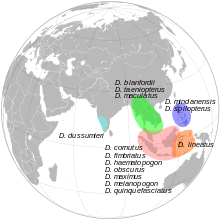Draco (genus)
![]()
This article is about the flying kite genus. For the corresponding aircraft, see hang glider.
![]()
This article has been entered for improvement due to formal or content deficiencies in the biology quality assurance. This is done to bring the quality of Biology articles to an acceptable level. Please help improve this article! Articles that are not significantly improved may be deleted if necessary.
Also read the more detailed information in the minimum requirements for biology articles.
The flying dragons (Draco) are a genus of the lizard family Agamas (Agamidae).
The lizards live on trees in the rainforests of Southeast Asia, especially on the islands of the Malay Archipelago and the Philippines.

The flight skin is stretched between the extended ribs
Features
The 20 to 26 centimetre long flying kites carry flight skins on five to eight extended ribs, with which they can sail from tree to tree in gliding flight. They usually only cover a few metres, but are also capable of gliding up to 60 metres. The skin sails, as well as the throat pouch, are often brightly coloured and are folded backwards at the side of the body when at rest.
Flying kites feed on insects, mainly tree-dwelling ants.
Only for the reproduction, the animals come on the ground to bury its up to four eggs.
Types
- Draco abbreviatus Hardwicke & Gray, 1827
- Draco affinis Bartlett, 1895
- Draco biaro Lazell, 1987
- Draco bimaculatus Günther, 1864
- Draco blanfordii Blanford, 1878
- Draco caerulhians Lazell, 1992
- Draco cornutus Günther, 1864
- Draco cristatellus Günther, 1872
- Draco cyanopterus Peters, 1867
- Draco dussumieri Duméril & Bibron, 1837
- Draco fimbriatus Kuhl, 1820
- Draco guentheri Boulenger, 1885
- Draco haematopogon Gray, 1831
- Draco indochinensis Smith, 1928 (sometimes synonymized with D. blanfordii)
- Draco jareckii Lazell, 1992
- Draco lineatus Daudin, 1802
- Spotted flying dragon (Draco maculatus (Gray, 1845))
- Draco maximus Boulenger, 1893
- Draco melanopogon Boulenger, 1887
- Draco mindanensis Stejneger, 1908
- Draco norvillii Alcock, 1895
- Draco obscurus Boulenger, 1887
- Draco ornatus (Gray, 1845)
- Draco palawanensis Mcguire & Alcala, 2000
- Draco quadrasi Boettger, 1893
- Draco quinquefasciatus Hardwicke & Gray, 1827
- Draco reticulatus Günther, 1864
- Draco spilopterus (Wiegmann, 1834)
- Draco taeniopterus Günther, 1861
- Timor flying dragon (Draco timoriensis Kuhl, 1820)
- Common flying dragon (Draco volans Linnaeus, 1758)

The distribution areas of the different types of flying kites
Questions and Answers
Q: What is Draco?
A: Draco is a genus of agamid lizards that are sometimes called flying dragons.
Q: How can Draco create a wing?
A: By extending the ribs and their connecting membrane, Draco can create a kind of wing.
Q: What do the flattened hindlimbs of Draco look like?
A: The flattened hindlimbs of Draco are wing-like in cross-section.
Q: What is the purpose of the small flaps on Draco's neck?
A: The small flaps on Draco's neck serve as horizontal stabilizers.
Q: How far can Draco glide?
A: Glides as long as 60 m have been recorded for Draco.
Q: How big is the smallest species of Draco?
A: The smallest species of Draco is only about 20 cm long.
Q: When is the only time a female flying lizard comes to the ground?
A: The only time a female flying lizard comes to the ground is when she is ready to lay her eggs.
Search within the encyclopedia